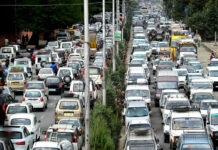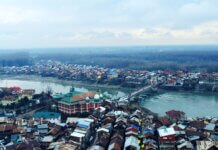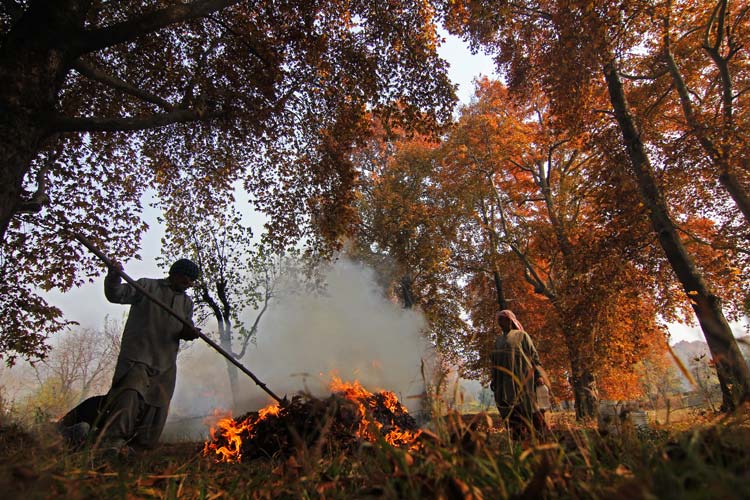As a day’s power cut throws life out of gear in Kashmir, Naeem Akhtar argues that people have deliberately yielded space to discomfort and we as a nation have surrendered more than the forces of change demand.
At sixty I belong to a generation that is perhaps the last link connecting the present with a past that is not so distant but qualitatively an eon away. And that difference becomes evident most strikingly in the winters.
There is always an element of nostalgia attached with the past, things one looks at romantically and misses. Even then there is no denying the fact that life now is much easier for the bulk of Kashmiris though it could be still better and culturally distinct only if we had been able to retain some good features of our past.
Winter as the other three seasons, spring, summer and autumn are constants of life. The variable is the response to each one of them. Winter of all, needs a special treatment by way of a response for the special requirements caused by it alone. Human genius did it over the millennia in its own silent, evolutionary way.
Life, till fifty years back in Kashmir too had a different pace and winters meant a real mass holiday for the outdoors. And to keep blood warm, people had accompaniments in the shape of a struggle inside darkened rooms of mud houses and small distractions from long unending nights. This was more pronounced in villages than in the only city Kashmir had, Srinagar.
Food in villages where I spent some of my childhood, revolved around rice, aanchaar (pickles), dried vegetables and daal. All locally produced. An expert in the village would by turns visit homes in late autumn to spice saag into aanchaar. Many people could not afford even this but fresh vegetable was something one could not even fantasize about.
 An animal in the village which was sick beyond recovery would provide the only opportunity of a non-veg meal. Weddings would generally be conducted in winters and looked forward to as the only celebrations and eating ‘carnivals’.
An animal in the village which was sick beyond recovery would provide the only opportunity of a non-veg meal. Weddings would generally be conducted in winters and looked forward to as the only celebrations and eating ‘carnivals’.
Women would generally spin wool in spare time while men would weave mats of grass and prepare ropes for them – rural crafts that are totally extinct now. The long inventory of live stock would be huge consumers of fodder but without even enough milk production for personal consumption. Tending the cattle would keep all family members busy but the tea would still invariably be black- called tyotth.
It would more often be accompanied by sattu or leftover boiled rice than any kind of bread. Bakeries would be confined to the city or towns. Among villages very few would have a baker, butcher or even a proper grocery.
Sheen was an inalienable part of winter. News would be not a snowfall but the rare absence of it. Snow would generate activity of its own with some economic fallout as well in the shape of road clearance that was done manually as bulldozers were yet to arrive. Roads would remain closed for weeks before traffic could ply on them and there would be no emergencies.
As most village folk – even the urbanites- were self employed, closure of roads would hardly matter much. Clearing the roofs, mostly thatched and sparingly shingled, was a permanent job for a few in the locality. It would be needed twice or even thrice a day on a snowing day. Heaps of snow would accumulate around houses and on sidewalks that would take months to melt.
Kangri continues to be the most loyal friend of Kashmiris through the ages. This contraption has seen us through worst times. There used to be a different version of it, exclusively earthen without the wicker jacket that was called mannan. It would generally be popular among the poorer sections as it would provide more heat than the semi insulated kangri to those with hardly any clothing on them except the pheran. But kangri otherwise would make best of winter gifts in different models.
A typically decorated, painted kangri with rings of wicker dangling around it would be available for the brides to be. It would usually go as a gift on the first winter after engagement to the bride from the groom’s parents. The best in the genre would come from Bandipora and Chrar.
For the city folks procurement of rice, fuel (firewood) and charcoal ahead of winter would be the greatest ambition. While the forced seclusion indoors would result in the creation of the masterpieces that gives Kashmir its artistic identity, food in the city was fun. Hareesa, dried and smoked fish, varieties of pulses and dried vegetables, murabbas, khameers, gulqand would give the place not just exclusivity but an unmatched aroma of grandeur, urbanity and class.
But the vegetable gardens inside the city would provide whatever fresh vegetable were available in any part of the valley. The sweet tasting winter saag, turnips, radish and the deep violet colored carrots would be it all. But like most of our good things the population explosion and wanton urbanization has eaten up the iconic vegetable gardens too.
One thing that we carry along through decades and generations is the eternal debate on the status of Srinagar-Jammu highway. The question wath chha yalleh? (Is the road open) has become part of pleasantries in Kashmir and promises to be so for quite some time. But it would not matter much those good old days as households would be well stocked with local produce preserved with natural methods.
It is a net loss that we have forgotten those methods and consequently become dependent on markets outside for everything from fodder for the cattle to charcoal for kangris, firewood for hamaams and food for humans. True, consumerism and an undeniable upgrade in living standards is bound to take its toll but it seems we as a nation have surrendered more than the forces of change would demand.
Another area in which we as a people have deliberately yielded space to discomfort is in the construction of homes. As a friend of mine observes, the arrival of the architect-engineer team cooked the goose for Kashmir. Till the time construction was in the hands of carpenter and mason we would produce architectural masterpieces that were also user friendly but the blind application of construction books taught in engineering schools has made life more difficult in winters – and summers. We now have houses that instead of making nature an ally in providing comfort are designed to fight it only through mechanical and not natural ways. That is why a day’s power cut throws our lives out of gear.
The ‘cement-e-Kashmir’ may be the brightest tagline ever coined out of Kashmir after the eternal hamien ast o, hamien ast o, hamien ast, but I for one would like to breathe my last in a mud plastered room, both for its sublimity and comfort.














